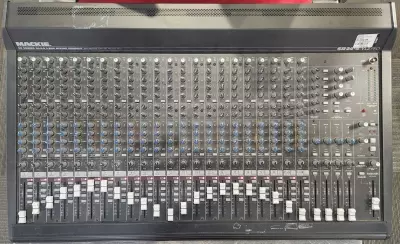Gear Hunter
Mackie SR24.4


Sale Price: $2225
Buy From Store
Customer responsible for any shipping charges.
Description
From Sound on Sound:
"The Mackie SR24:4 combines 20 mic/line channel strips with two stereo, line‑only strips and four stereo returns, making a total of 32 different ways of getting a signal into the mixer (not counting the 2‑track inputs). All the input channel strips have six aux sends, and unlike some desks that use buss switching, each of the SR24:4's sends feeds its own dedicated buss. Sends 1 and 2 are dedicated pre‑fade sends, for foldback or cue mix applications, while Sends 3 and 4 may be switched as a pair to function in either pre‑ or post‑fade mode. Sends 5 and 6 are fixed post‑fade for use as effects sends, and each send buss has its own level control and Solo button in the master section of the console.
The mic/line channels differ from the stereo channels in that they are fitted with a 3‑band equaliser, complete with sweep mid and switchable low‑cut filter, while the stereo channels use a 4‑band, fixed‑frequency EQ system. All the mic/line channels have globally switchable phantom power, plus insert points on stereo jacks.
The routing system is quite conventional, with separate routing buttons for L‑R, 1‑2 and 3‑4, where the Pan control steers the signal between left and right, or odd and even numbered busses in the traditional way. A large channel Mute button is located below the Pan control, and all channels have the benefit of a Solo switch as well as green and red LEDs indicating ‑20dB and overload signal levels. A clever touch is the Solo/Mute status LED which blinks if a channel is solo'd, but remains on if the channel is muted.
The master section of this console is refreshingly uncluttered, yet nothing essential is missed out. Level controls are provided for all six auxiliary sends and four stereo returns, and to add to the routing flexibility, Aux Return 4 may be routed to either pair of groups, or to the L‑R mix. There are two further controls for sound reinforcement work which allow independently adjustable amounts of effects to be fed into the Aux 1 and Aux 2 foldback mix. A single Solo button allows all the stereo aux returns to be solo'd globally.
Each of the four Group faders may be assigned to the L‑R mix via a L‑R Assign button, and unlike many mixers which irritatingly route all odd numbered groups left and even numbered groups right, this one has a Pan pot above each Group fader, as well as a Solo button, and an intriguingly named 'Air' knob (see 'Equalisation' box).
Over on the far right is Michael Portillo — no, just kidding — a BNC connector to accept a gooseneck lamp, the stereo bargraph meters, and status LEDs for Solo and Power, but there is no status LED for the phantom power, which I find mildly alarming. The Solo Mode button is accompanied by a Level control which makes it possible to PFL a channel without having your eardrums meet in the middle of your head — a thoughtful touch; talkback is also provided. You can opt to talk into the main mix or to Aux 1 and 2, but you have to use your own mic plugged into an XLR socket on the rear panel — there's no built‑in capsule."


